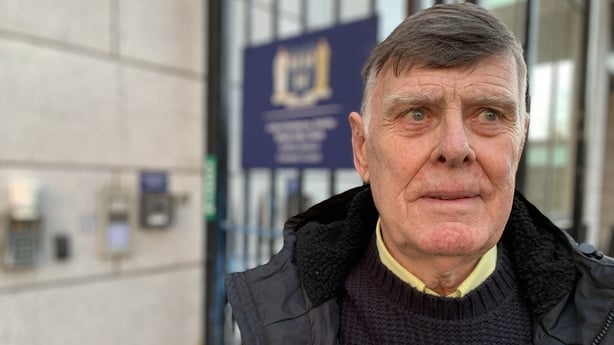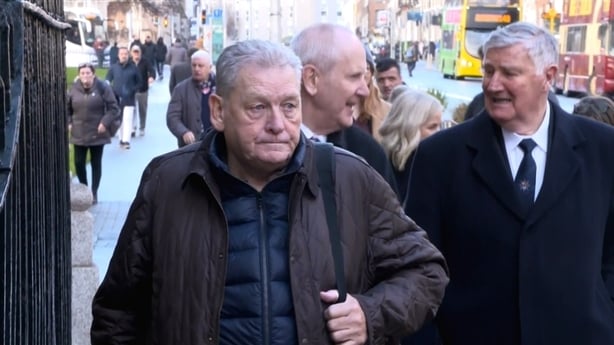We've heard from the families of the victims, the staff and management of the Stardust, and the survivors.
Over the last number of weeks, it was turn of the first responders to take to the witness box at the Dublin District Coroner’s Court.
Their accounts of what they experienced at the scene were often graphic and moving.
Dressed in a dark suit, white shirt and tie, William McQuaid cut an imposing figure.
Tall and broad, the 85-year-old still carries an air of authority with him.
At the time of the Stardust fire, he was a 43-year-old senior officer with Dublin Fire Brigade.
He had joined the service in 1961. The tie he wore in the witness box was emblazoned with the brigade’s emblem.
When he spoke into the microphone he did so with confidence.
What was also evident was that despite the decades in the fire service and the decades that have passed since the Artane blaze, the events in the early hours of Saturday 14 February 1981 have stayed with him.
What happened was a "national tragedy", he said.
"A total catastrophe’ for the local community that left a lasting effect.
William McQuaid was one of around a dozen former firemen and gardai who gave evidence to these inquests over the last number of weeks. Their testimony has now concluded but their harrowing accounts have left its mark.
Alarm raised
From the initial call to the emergency services, it was clear that the fire at the Stardust was a major one. The first contact came into the Tara St control centre at 1.43am with Kilbarrack and North Strand fire stations notified.
In the control centre at the time was Dermot Dowdall, a 26-year-old firefighter.
The court heard how he then took a call from John Fitzsimons who was working that night as a doorman at the club and who was also a fireman with Dublin Fire Brigade.
Dermot Dowdall said John Fitzsimons conveyed the seriousness of the situation and told him "we could lose up to 200 people here tonight."
He said he could hear the "chaos" in the background and said John Fitzsimons was emphasising the level of distress, saying it was "district call" which meant it was a serious fire.
"We were fully aware of what we were going to, we’d no allusions," he said.
The first unit of the fire brigade from Kilbarrack arrived on the scene at 1.51am followed by a fleet of appliances and ambulances from North Strand and Tara St.
Phase 1 of the Emergency Action Plan was put in place at 2.06am which mobilised extra resources.
Six minutes later, phase 2 was implemented.
The court heard how at 2.20am, the fire had been brought under control and all the injured had been removed.
At 2.54am the action plan was stood down. What’s clear though is that it was in the first minutes of the blaze sweeping through the nightclub that much of the destruction was caused.
The response
Dermot Dowdall was driving an ambulance on the night and said he arrived on scene at around 1.49am.
He said the fire was "very intense" and "very fast".’ It had gone through the roof, and had largely vented itself when he arrived.
"The fire essentially reached its peak very, very quickly before a brigade ever got there", he said all the damage was done in five minutes.
William McQuaid told the court that it was an "accelerated fire" and said seeing the ceiling collapsed indicated to him that the temperature of the fire must have been "way above the normal temperature you would get in a normal fire".
"There was something in the building that contributed to the fast spread of the fire,’’ he said.
Others spoke of the panic they encountered on arrival.
Matthew Quinn was one of the first emergency responders on the scene.

He was 33 at the time and had been a member of An Garda Síochána for 11 years.
He had been in a patrol car in Santry when he received a call telling of the fire at the nightclub.
En route to the club from some distance away, he said "the whole sky was lit up red or orange".
He said outside the club there was "pure panic" and said people were screaming and shouting.
"All I remember was seeing the injured and what went through my head was to get them to hospital as soon as possible," he told the court.
He described putting one person into the front seat of his car and two into the back.
"I went to put a third person in (the back) but because they couldn't touch one another, they were screeching, I had to get that person to leave."
He also described their injuries and said: "The blisters that were on their arms were massive.
"Some of them had burst and the skin…had fallen down over their fingers…like you’d peel a banana. It was terrible," he told the court.
The rescues
The inquests were told too of the rescues carried out and the lives saved.
Former firefighter Noel Hosback described how he climbed through a window and kicked in the door of the ladies’ toilets searching for those trapped.
He discovered three people.
"They were very scared", he said and were "kneeling on the floor".
Along with others, he led them to safety.
The court heard how one of them he saved was Deirdre Dames who was present in court while Noel Hosback was giving evidence.
Afterwards, in the lobby outside, the pair hugged.
There were other accounts of rescues too.
Patrick Hobbs described how he and colleagues entered the building and saved "five or six" people who were trapped in the toilets.
"They were in shock, and in an awful state," he said in court today.
He agreed that the only people capable of being rescued were those who had found shelter in the toilets and the situation in the ballroom was such that it was incompatible with life.
The recovery operation
The firemen also spoke about the "gruesome work" of the recovery operation as the ballroom still smouldered.
James Tormey described finding the remains of one of the victims inside the doors of an emergency exit "just two or three steps from safety".
Mr Tormey recalled how he found two bodies on the steps of a seating area and that it seemed like they had their "young arms around each other" and said their bodies "were fused as one".
"I thought at the time, that those people were trying to comfort each other before their demise," he said.
13 ambulances were involved in ferrying the dead to the city morgue that morning between 3.30am and 4.05am.

Patrick O'Connell was one of the gardaí who escorted them.
The court heard how he helped make room in the morgue.
"We made space … by moving trollies to accommodate the large amount of bodies which were being brought in.
"There were eventually forty bodies lying throughout the morgue."
A temporary tent was erected in the yard to accommodate the large number of dead.
The investigation
The jury also heard during this module that over 1,500 statements were taken by gardaí and that there was no evidence from them which indicated the fire was malicious.
They also heard how a garda inspected the emergency exits after the fire and found chains locked with padlocks hanging off the panic bars of the exit doors 1,3,4 and 5.
The hearings
The inquests have now finished hearing evidence from the emergency responders and will resume in the second week of January.
It’s due to hear pathology evidence followed by testimony from fire experts when the focus will turn to examine the location of the fire, the cause and the speed in which it spread.
Throughout the evidence from the former fire and garda officers, the coroner Dr Myra Cullinane advised the families present in court and watching online that the details they would be hearing would be upsetting.
That guidance was issued again on the last day of the hearings before the Christmas break when graphic footage was played in court showing fireman carrying lifeless bodies from the building.
At times, the upset from the relatives was clear to see. Others too spoke of their distress.
At the conclusion of his evidence earlier in the month, former garda sergeant Bernard McMahon said he wished to express his condolences to the families of those who lost their lives.
At the conclusion of his evidence, former garda sergeant Bernard McMahon said he wished to express his condolences to the families of those who lost their lives.
"I was affected myself, and my family, and I just can appreciate what they have gone through in the meantime," he said.
"I think it's ironic that after 42 years we're still here."







